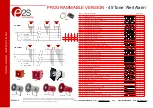
20
21
maximum anticipated rate of tissue cutting, thereby minimizing
unnecessary (thermal) necrosis of tissue. The determination of
the appropriate set point temperature is determined by the
surgeon by raising the set point temperature
until
adequate
hemostasis is achieved. Alternatively, the surgeon can, at any
selected point temperature, modulate the speed of tissue cutting
according to the vascularity of the tissue being incised.
3.
SEALING BLEEDERS
•
The heat from the Hemostatix Thermal Scalpel blade will seal
most (less than 2mm in diameter) blood vessels as they are cut.
•
For a vessel not sealed as it is cut, promptly use the blade’s heat
to seal it by exerting light pressure on the bleeder with the flat
side of the blade.
•
For larger bleeders, activate the Thermal COAG mode by
depressing and holding down the
blue
Thermal COAG switch
(or
optional footswitch pedal) and holding the flat side of the
blade
on the bleeder until hemostasis is achieved.
4.
MAINTAIN A DRY OPERATIVE FIELD
•
The most effective use of the Hemostatix Thermal Scalpel
thermal energy such that bleeding does not begin. This is done
by making incisions using long, relatively slow, authoritative
strokes (rather than short, “choppy” strokes) to maintain
constant and meticulous hemostasis at every step, and prevent
the onset of bleeding.
•
Bleeding vessels are sealed by the direct contact of the hot
blade
to tissue, thus providing heat transfer to the tissue at the
bleeding site. Accordingly, if pools of blood occur from vessels
not sealed as they are cut, suction or sponge the area before
applying the Hemostatix Thermal Scalpel blade to seal the
bleeders. Heat from the blade dissipates in pools of blood and
cannot get through these pools to reach the tissue to seal the
bleeder. Pools of blood simply coagulate on the blade, thermally
insulating it.
5.
CHANGING THE BLADE
If the blade becomes dull or the change blade message appears on
the controller display, switch the handle ON/OFF switch to off
and wait for the temperature display to turn Green indicating the
blade is safe to handle. Replace the dull or damaged blade with a
new blade.
CAUTION: To remove a blade from the handle,
grab the
plastic hub and
pull the blade straight out of the handle.
Bending, twisting or flexing the blade could damage the
blade contacts and retainers within the handle causing it
to no longer function.
CAUTION: Used blades are surgically sharp and may be
extremely hot to the touch. Always use a sponge, clamp or
hemostat to grasp the used blade. Always follow proper
sharps precautions when handling a blade and biohazard
disposal techniques when discarding a used blade.
6. CLEANING THE BLADE DURING USE
Clean any coagulated blood or tissue debris from a HOT blade by
LIGHTLY wiping the blade using DRY 4x4 gauze. Using WET
gauze will cool the blade causing the blood and coagulum to
adhere to the surface of the blade. Only light pressure is needed.
Excess pressure will result in the bending of the blade and the
subsequent damage to the blade electrical circuit.
NOTE
: The Teflon non-stick coating cleans most effectively
when hot. Best results are obtained using dry 4x4 gauze when
the blade is hot.
NOTE
: If the blade becomes accidentally dislodged from the
handle, turn the handle OFF, dip the blade in sterile water
or saline solution to cool it to room temperature, and then
reinsert it. Accurate calibration can only be achieved if the
blade is at room temperature when it is inserted into the
handle.
CAUTION: Care should be taken not to bend the blade
while cleaning, insertion, or reinsertion as the heater leads
may become broken and the blade stop working.
CAUTION: Never use any type of abrasive pad to clean the
blades. The abrasives will damage the circuit and render
the blade unusable.





































